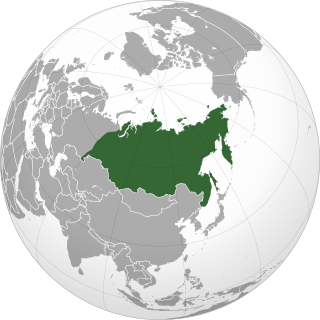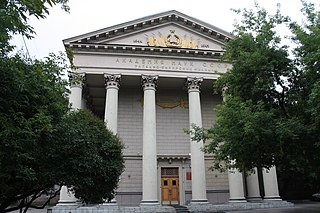
Hydrology is the scientific study of the movement, distribution, and management of water on Earth and other planets, including the water cycle, water resources, and drainage basin sustainability. A practitioner of hydrology is called a hydrologist. Hydrologists are scientists studying earth or environmental science, civil or environmental engineering, and physical geography. Using various analytical methods and scientific techniques, they collect and analyze data to help solve water related problems such as environmental preservation, natural disasters, and water management.

Physical geography is one of the three main branches of geography. Physical geography is the branch of natural science which deals with the processes and patterns in the natural environment such as the atmosphere, hydrosphere, biosphere, and geosphere. This focus is in contrast with the branch of human geography, which focuses on the built environment, and technical geography, which focuses on using, studying, and creating tools to obtain,analyze, interpret, and understand spatial information. The three branches have significant overlap, however.


Siberia is an extensive geographical region comprising all of North Asia, from the Ural Mountains in the west to the Pacific Ocean in the east. It has formed part of the sovereign territory of Russia and its various predecessor states since the centuries-long conquest of Siberia, which began with the fall of the Khanate of Sibir in the late 16th century and concluded with the annexation of Chukotka in 1778. Siberia is vast and sparsely populated, covering an area of over 13.1 million square kilometres (5,100,000 sq mi), but home to only one-fifth of Russia's population. Novosibirsk, Omsk, and Chelyabinsk are the largest cities in the area.

The Soviet Union incorporated an area of over 22,402,200 square kilometres (8,649,500 sq mi), covering approximately one-sixth of Earth's land surface. It was only slightly smaller in land area than the entire continent of North America and spanned most of Eurasia. Its largest and most populous republic was the Russian SFSR which covered roughly three-quarters of the surface area of the union, including the complete territory of contemporary Russia.

The Russian Academy of Sciences consists of the national academy of Russia; a network of scientific research institutes from across the Russian Federation; and additional scientific and social units such as libraries, publishing units, and hospitals.

The following outline is provided as an overview of and topical guide to geography:

State Public Scientific and Technological Library of the Siberian Branch of the Russian Academy of Sciences (SPSTL SB RAS) is the largest library in Russia east of the Urals, the State Universal Book repository of Siberia, an Informational Center of the federal level, head library of the centralized system. Here are located the Museum of Book, Siberian Regional Library Center of Continuous Education (SRLCCE), Siberian Regional Center of Document Conservation, Multi-functional Regional Center for Patent and Informational Services in the sphere of protection of intellectual property objects. The Library is the only research institute in the East of the country in the field of librarianship and bibliology with 26 specialists having candidate degree and 6 – Doctor degree.

The Patomskiy crater or Patom crater, also known as Конус Колпакова, Konus Kolpakova "Kolpakov cone") is a peculiar rock formation located in the Bodaibo District of the Irkutsk region of southeastern Siberia, 360 kilometres (220 mi) from the district center Bodaibo. It is a large mound made of shattered limestone blocks on the slopes of the Patom Highlands in an area of dense taiga. Its base diameter is about 160 metres (520 ft) and its height about 40 metres (130 ft); the cone's crown is ring-shaped, and in its center there is a smaller mound with a height of about 12 metres (39 ft). The volume of the crater is estimated as 230,000–250,000 cubic metres (8,100,000–8,800,000 cu ft), with a weight of about one million tons.
Institute of Geography may refer to:

The Institute of Systematics and Ecology of Animals (ISEA) located in Novosibirsk is one of the oldest research organization in the Siberian Branch of the Russian Academy of Sciences. The institute was founded in 1944 as Biomedical Institute, the first Siberian academic establishment working in biology. The Siberian Zoological Museum of the ISEA SB RAS has the third-largest coleopteran collection in Russia. Some Siberian research organizations as the Central Siberian Botanical Garden SB RAS and the Institute of Soil Science and Agricultural Chemistry SB RAS were derived from the Institute former laboratories.

Pavel Dolukhanov was a doctor of geographical sciences, professor, emeritus professor (2002), Russian and British paleogeographer and archaeologist at the Institute of History of Material Culture (IHMC), RAS (1959–1989) and the University of Newcastle, United Kingdom (1990–2009), a specialist in archaeology and paleoenvironment of Northern Eurasia. He taught and made research at the Leningrad State University, the University of Newcastle (UK), the Institute of Paleontology in Paris and the International Research Center.

The Institute of History of Siberian Branch of the Russian Academy of Sciences is a part of the Historical and Philological Studies Department of the Russian Academy of Sciences. Currently, as a result of the dissolution of the Russian Academy of Sciences, the Institute is subordinate to the Federal Agency of Scientific Institutions. It is focused on comprehensive studies of history of Siberia in from the 16th to the 20th centuries.

Institute of Soil Science and Agrochemistry is a research institute in Akademgorodok of Novosibirsk, Russia. It was founded in 1968.
The Pacific Institute of Geography of the Far Eastern Branch of the Russian Academy of Sciences (abbr. TIG FEB RAS) is a research institute of the Far Eastern Branch of the Russian Academy of Sciences, organized in 1971. It is the leading scientific institution of geographic profile in the Russian Far East. It is located in Vladivostok.
Vakhushti Bagrationi Institute of Geography is a scientific research institution, which founded in 1933 on the basis of the Faculty of Geography of the Tbilisi State University in the city of Tbilisi. Some Attempts of establishing geographical institutions in Georgia were undertaken even earlier. The initiator and inspirer of this event was academician Alexander Javakhishvili. In its first year the Institute published 13 works with 50 various thematic maps. The Georgian Academy of Sciences was created in 1941, while the Institute joined it in 1945, and in that same year was re-named after the Georgian scientist Vakhushti Bagrationi. When the Institute was founded, it focused primarily on physical-geographical and economic-geographical research on separate administrative Georgian districts, and created relevant maps. Key features of the Georgian climate were studied. The Institute returned to TSU in 2010.
Institute of Archaeology and Ethnography of the Siberian Branch of the RAS, IAET SB RAS is a research institute in Novosibirsk, Russia. It was founded in 1990.

The West Siberian Branch of the Academy of Sciences of the Soviet Union was a Soviet research institution, a branch of the Academy of Sciences of the Soviet Union, that existed from 1944 to 1958. Its head office was located in Novosibirsk. The organization preceded the establishment of Novosibirsk Scientific Center of the SB AS USSR.













